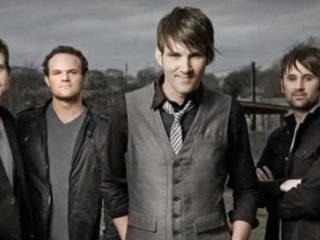Collide-oscope
At first glance, many would conclude that David Crowder stands out in a crowd. And now, we find out it’s not just the facial hair that’s the dead giveaway. In light of the Sept. 27 release of his band’s stunning new recording, A Collision, we decided to find out more about what makes this Waco, Texas, worship leader tick, not to mention why his wife would prefer he not invite complete strangers over for dinner again any time soon.
David Crowder is so focused on the creative process these days that somehow he’s managed to misplace his cup of coffee — a “giant” cup of coffee in his own house, no less. But even without his caffeine fix, he forges forward because, well, there’s work to be done.
In addition to CCM’s interview this particular Monday afternoon, he’s adding a few finishing touches to his band’s album that were technically due to his record label a couple of weeks before. Even though these modifications are minor in the musical grand scheme, he wants to make sure everything sounds just right. And that’s understandable, given the new project’s ambitious nature. After all, this span-the-genres effort the David Crowder Band is about to unleash really isn’t like anything you’ve heard in Christian music to date, a fact that probably won’t surprise many long-time Crowder fans.
And while that promise of “something you’ve never heard before” usually makes for compelling marketing copy but doesn’t deliver much more, it’s actually true this time around with A Collision, his band’s third full-length, major-label record (third, if you don’t count all the little side projects and remixes such as Sunsets & Sushi — Experiments in Spectral Deconstruction, The Lime CD and more that they’ve released in between).
Now granted, Crowder, who got his start leading worship at Texas’ Baylor University and helped found University Baptist Church, has never been the prototypical worship leader, even though that’s what he’s probably best known for as one of the most distinctive, instantly recognizable faces of the “Passion” worship movement. With his lanky build and the black, thick-rimmed glasses your grandpa would’ve called “spectacles” back in the day, not to mention that one-of-a-kind facial hair he sports, his music hasn’t necessarily fit the traditional praise & worship mold either. But despite the fact that his songs aren’t as ubiquitous as, say, “Blessed Be Your Name” or “Shout to the Lord,” several of them — including “You Alone,” “Our Love Is Loud” and “Come Thou Fount” — are sung in Sunday morning worship services worldwide.
She Blinded Me with Science
What exactly is it that separates A Collision from the rest of the pack? Well, for starters, how many CDs do you know that were initially inspired by a science book? “It all started with this book my wife found while shopping at an antiques store in downtown Chicago where I was playing a show,” Crowder recalls. “It was The Story of Atomic Energy by Laura Fermi. She was a peace activist but also the wife of a famous physicist. For those who don’t know, the Fermi National Accelerator Laboratory, which is home to the most powerful atom collider in the world, just happens to be located outside of Chicago.”
Thinking it interesting that his wife would “procure this particular book” on a wintry day in Chicago, the self-proclaimed lover of “semiotics, symbols and iconography” was immediately captivated by the image on its cover. “It was this pale green book with the usual depiction of a nucleus with electrons swirling around it,” Crowder says. “As I looked at it, I thought it was so cool that this book about energy had a symbol that represented energy on its cover. It didn’t have any words, but yet I still understood that they were going to be talking about energy inside.”
And it was that literary find in a stack of used books that helped inspire the concept behind A Collision. “When it comes down to it, this model is improper in its depiction of particular matter,” he adds. “We know that electrons don’t circle in elliptical paths around a nucleus. And this is why symbols aren’t always a correct depiction. They are always a little broken. And when I thought about it while freezing in the middle of a downtown Chicago intersection, this incomplete drawing helped me realize that this is what art really is. We are creating what ends up being broken containers.”
As he talks, there’s almost a giddy enthusiasm in his voice when he recalls that afternoon in Chicago that changed the course of A Collision. Well, that, plus a little bluegrass thrown in for good measure, and a tragedy.
An Introduction to Bluegrass and Tragedy
Now if you’ve heard any of Crowder’s previous efforts, you know there’s nary a fiddle to speak of. He and his band were presented with a challenge, a triple-dog dare if you will, from the grandfather of one of Crowder’s bandmates after a show in Dallas: “You boys should do a bluegrass number, as it is the superior variety of music!” And so began what Crowder calls “his eschatology of bluegrass.”
As Crowder became a student of the genre, he discovered that most bluegrass songs share something in common: a yearning for heaven that is often referred to as “the sweet by and by” or “flying away to glory.” At first, Crowder was a bit disturbed by what he found. “It seemed there was this glaring, unbalanced doctrinal depiction of the kingdom of heaven,” he comments. “So I had this fear that this approach to Christian living has led many a person’s head into the clouds and allowed them to justify neglecting bringing the kingdom of heaven into the here and now.”
But his apprehensions were quickly put to rest.
Copyright © 2005 CCM Magazine, Used by Permission
Like what you’re reading?
Get the full scoop by subscribing to CCM today! Click Here











